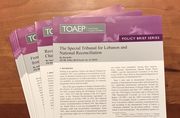Table of contents:
5. The perpetrator seized, detained or otherwise held hostage one or more persons.
5.1 The perpetrator seized one or more persons ; OR
5.2 The perpetrator detained or otherwise held hostage one or more persons; OR
5.2.1 Evidence of detention of one or more persons in an enclosed space
5.2.2 Evidence of detention of one or more persons in other non-enclosed location
5.2.3 Evidence that detention constitutes an unlawful deprivation of the victim's liberty.
5.3 The perpetrator otherwise held hostage one or more persons.
Element:
5. The perpetrator seized, detained or otherwise held hostage one or more persons.
ICTY
The Kordić Trial Judgment stated:
"the Chamber finds that an individual commits the offence of taking civilians as hostages when he threatens to subject civilians, who are unlawfully detained, to inhuman treatment or death as a means of achieving the fulfilment of a condition."[1]
"468. In addition to fulfilling the chapeau requirements for Article 3, the offence of hostagetaking requires the following elements. The actus reus of this offence is the detention of persons and the use of a threat concerning the detained persons, including a threat to kill, injure or continue to detain, in order to obtain a concession or gain an advantage. The Appeals Chamber has held that the prohibition on the taking of hostages pursuant to Common Article 3 applies to “all detained individuals, irrespective of whether their detention is explicitly sought in order to use them as hostages and irrespective of their prior status as combatants”. The mens rea required for hostage-taking is the intention to compel a third party to act or refrain from acting as a condition for the release of the detained persons. Because the essential feature of the offence of hostagetaking is the use of a threat to detainees to obtain a concession or gain an advantage, which may happen at any time during the detention, the requisite intent may be formed at the time of the detention or it may be formed at some later time, after the person has been detained. The erroneous belief that detained combatants are not entitled to Common Article 3 protections is not a defence should the elements of hostage-taking be met."
SCSL
The Sesay, Kallon and Gbao Trial Chamber found:
"The Chamber finds that the Prosecution has proved beyond reasonable doubt that RUF fighters seized hundreds of UNAMSIL peacekeepers in eight attacks and detained them at locations including Teko Barracks in Makeni, Bombali District and Small Sefadu, Yengema and Tombodu in Kono District, thus fulfilling the first element of the offence of hostage taking"[2]
5.1 The perpetrator seized one or more persons ; OR
5.2 The perpetrator detained or otherwise held hostage one or more persons; OR
As the Kordić and Čerkez Trial Chamber noted,
"It would, thus, appear that the crime of taking civilians as hostages consists of the unlawful deprivation of liberty, including the crime of unlawful confinement."[3]
The Blaškić Trial Judgment also acknowledges that:
"civilian hostages are persons unlawfully deprived of their freedom, often arbitrarily and sometimes under threat of death. However, as asserted by the Defence, detention may be lawful in some circumstances, inter alia to protect civilians or when security reasons so impel. The Prosecution must establish that, at the time of the supposed detention, the allegedly censurable act was perpetrated in order to obtain a concession or gain an advantage. The elements of the offence are similar to those of Article 3(b) of the Geneva Conventions covered under Article 3 of the Statute."[4]
5.2.1 Evidence of detention of one or more persons in an enclosed space
5.2.2 Evidence of detention of one or more persons in other non-enclosed location
5.2.3 Evidence that detention constitutes an unlawful deprivation of the victim's liberty.
5.3 The perpetrator otherwise held hostage one or more persons.
Footnotes:
[1] ICTY, Kordić and Čerkez Trial Judgment, 26 February 2001, para. 314.
[2] SCSL, Sesay, Kallon and GbaoTrial Judgment, 2 March 2009, para. 1963.
[3] ICTY, Kordić and Čerkez Trial Judgment, 26 February 2001, para. 312.
[4] ICTY, Blaškić Trial Judgment, 3 March 2000, para. 158 (footnotes omitted).







